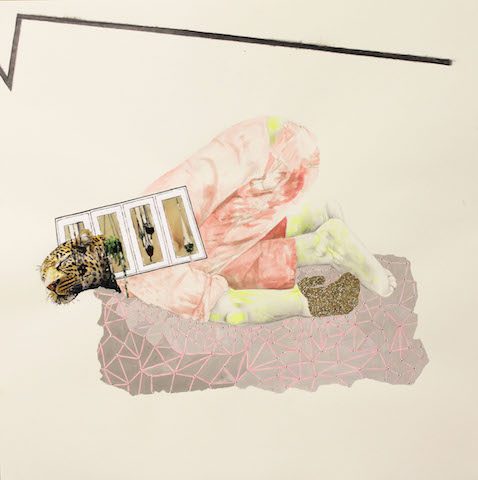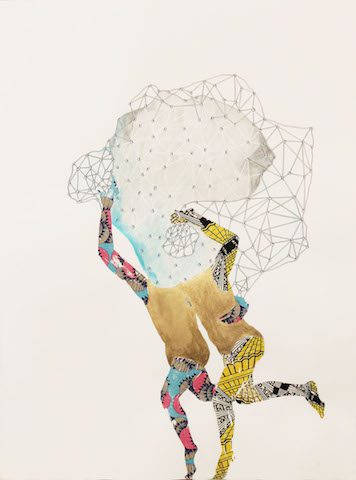C& talks to artist ruby onyinyechi amanze about developing new narratives

ruby onyinyechi amanze, Audre ́s Sweetest Dream, 2015. Drawing. Courtesy of the artist and Mariane Ibrahim Gallery
Well known for her drawings and works on paper, Nigerian-born artist ruby onyinyechi amanze talks about developing new narratives that respond to her growth as an artist living in the US.
C&: What brought you to drawing?
ruby onyinyechi amanze: I came into art through drawing – it was my first love. In school I studied photography and textiles, but my interest in both came down to the analogous process of working with layers. At the time, I didn’t have the language to think of drawing outside of its traditional parameters, but essentially much of my photographs and textile works were, in some ways, drawings. I returned to paper in grad school and have stayed engrossed in it ever since.
C&: A central theme of your practice is the notion of place/displacement. Where does this focus stem from?
roa: I’m interested in space because of how malleable and limitless it is. How I can hold space between my hands, how I can stretch it or turn it upside down, play with the tension. Place is far less fluid. It’s a fixed notion and also quite arbitrary and stale in its design. My work isn’t about a definite nation or geography. I’m not interested in making art about where I’m from. I’m from everywhere and nowhere. And I often wonder why it is even important…
As for displacement, that used to be my story, but it outstretched its purpose along with other growing pains a while ago. When I identified with the word, it was a woe-is-me victim story of being uprooted or of searching for something that was lost or taken from me. I’ve found a new language now that doesn’t carry the negative undertone of being displaced. I’ve lived in England, the US, and Nigeria and will live in many more places to come, but I haven’t lost a thing and I’m certainly not broken. Yes, my connections to and memory of each place are compiled of bits and pieces, but that’s just what the story is at this point, and I’m exactly where I’m supposed to be.

ruby onyinyechi amanze, carrying a cloud is easy, if you know how, 2015. Drawing. Courtesy of the artist and Mariane Ibrahim Gallery
C&: In your body of work, you use a range of figures and characters that have futuristic elements. Can you tell us a bit about this aesthetic choice and process?
roa: I think of it in two parts: I incorporate certain motifs or compositional choices that suggest a fourth dimension – a shifting of time and space. I’m intrigued by how simply this can happen, for example by flying over the ocean and losing or gaining an entire day. The second part is that it’s all in the present moment and less about the future. Being able to leave Earth for another world can actually happen physically or metaphysically. I’ve walked down streets in Brooklyn and everything, other than my body, has been walking down streets in Lagos. People have gone to the moon, had a conversation out there, and a week later, they were back in their homes on earth. Many indigenous peoples all over the world have, for centuries, been able to manipulate other dimensions of being. I’m interested in all of these things as they relate to the present moment.
![ruby onyinyechi amanze, Water and Air [Shelby], 2015. Drawing. Courtesy of the artist and Mariane Ibrahim Gallery](https://contemporaryand.com/wp-content/uploads/2016/02/Ruby-Amanze-Water-and-Air-Shelby-2015-©Mariane-Ibrahim-Kopie.jpg)
ruby onyinyechi amanze, Water and Air [Shelby], 2015. Drawing. Courtesy of the artist and Mariane Ibrahim Gallery
roa: I’m not sure that I’ve really experienced concrete conversations or links. And I think it’s dangerous territory that these “groups” even exist. I think for many Black artists working in the Diaspora or in Africa, there could potentially be that same number of conversations. The similarity of skin color (possibly) and, of course, the global and historic ways in which others have responded (and sometimes still do) to brown-skinned peoples are in some ways the only connection these two groups have (other than just being human). Even amongst “themselves” – for example, a Kenyan artist working in Kenya and a Moroccan artist working in Morocco – there has rarely existed an automatic shared experience by virtue of being on the same continent. Their day-to-day life may be as different as those of a Scot and a Turk, who also happen to share a continent. Despite this, there will always be parallel conversations happening because many artists, regardless of race, ethnicity, or geography, are thinking of similar things.
I think when it comes to visibility, the Diaspora has perhaps afforded Black artists (including those of direct African descent who have lived in the Diaspora for a long period) an entry into global art platforms – though by no means am I suggesting that we as a society have reached any form of equality when it comes to visibility for non-white artists. I think there is an excitement about what Black and African artists are doing right now, but only in separation from what everyone is doing. It’s tricky, because visibility is important, but so is inclusion.
.
Interview by Aïcha Diallo
More Editorial